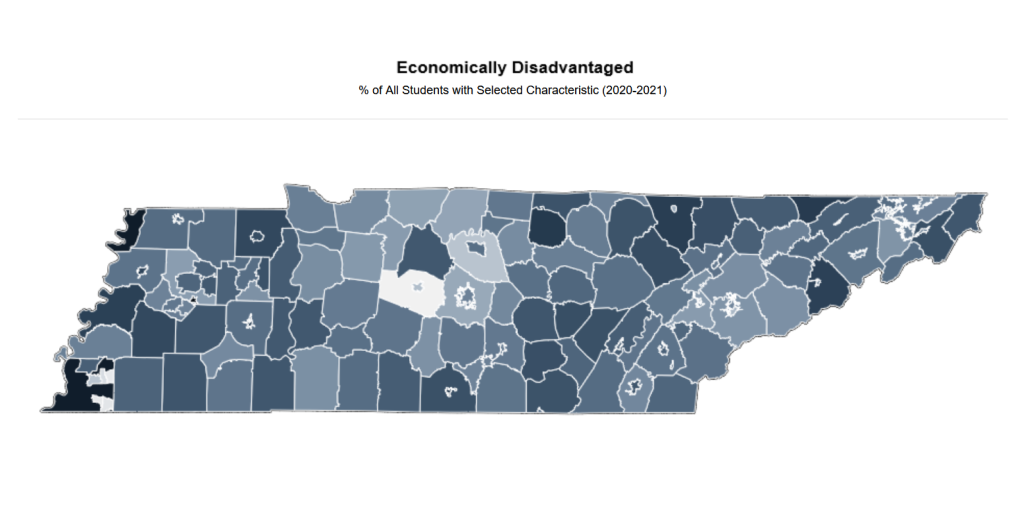
Gov. Bill Lee has proposed replacing Tennessee’s current K-12 education funding formula with a new calculation that gives extra weight to certain student and district-level characteristics. If the proposed Tennessee Investment in Student Achievement (TISA) formula becomes law, these characteristics would help determine how much state funding goes to each district. Future reports will explore other key elements of that calculation, including fiscal capacity.
Adopting TISA would change the state’s general approach to calculating the cost of an adequate K-12 education for all Tennessee students. Tennessee’s current funding formula, the Basic Education Program (BEP), takes a “resource-based” approach that uses the costs of dozens of inputs and resources to determine funding levels. The TISA formula proposed by Gov. Lee uses a “student-based” approach with a standard amount per pupil and adjustments for students who have additional needs. (1)
The dashboard below shows how the factors that drive overall funding levels under TISA vary across Tennessee’s 140 school districts.[i] These numbers do not by themselves determine the amount of state funding that each district would get. Like the BEP, the TISA formula ultimately answers three core questions that together would determine how much money each school district receives from the state and how much locals must spend. They are:
- Total Size of the Pie: What does it cost to provide an “adequate” education to every child in Tennessee?
- Total State/Local Split: How much of that total cost does the state cover, and how much do locals cover?
- District-Specific Split: How much does each specific district receive from the state?
This dashboard focuses on some key variables the TISA formula uses to answer question one about the total size of the pie.
[i] Note: This dashboard provides 2020-2021 data on student counts and characteristics associated with the core TISA student-weighted formula. It does not reflect information that would drive direct funding proposed for K-3 literacy, 4th grade tutoring, career and technical education, ACT testing, outcomes, fast growing districts, or salary equity.
References
Click to Open/Close
- EdBuild. Key Elements of Funding. FundEd: State Education Funding Policies for All 50 States. [Online] March 21, 2022. http://funded.edbuild.org/.
Dashboard Sources:
Student Characteristic Data: Tennessee Department of Education. 2020-2021 District Level Profile Data File. March 2022. Retrieved on March 11, 2022 from https://www.tn.gov/education/data/data-downloads.html.
Average Daily Membership: Tennessee Department of Education. 2021 Annual Statistical Report. Retrieved on March 11, 2022 from https://www.tn.gov/education/data/department-reports/2021-annual-statistical-report.html.
Title I and Charter Schools: National Center for Education Statistics. Public School Locator. Common Core of Data 2020-2021 School year. Retrieved on March 9, 2022 from https://nces.ed.gov/ccd/schoolsearch/school_list.asp?Search=1&InstName=&SchoolID=&Address=&City=&State=47&Zip=&Miles=&County=&PhoneAreaCode=&Phone=&DistrictName=&DistrictID=&SchoolType=1&SchoolType=2&SpecificSchlTypes=all&IncGrade=-1&LoGrade=-1&HiGrade=-1.
Small/Sparse Schools: Tennessee Department of Education. Districts Qualifying for Small and Sparse Weights. 2022. https://www.tn.gov/content/dam/tn/education/2021-funding-engagement/TISA%20Districts%20Small%20Sparse%20Weights.pdf.
Unique Learning Needs Weights: Tennessee Department of Education. Unique Learning Needs Crosswalk. 2022. https://www.tn.gov/content/dam/tn/education/2021-funding-engagement/TISA%20Unique%20Learning%20Needs%20Crosswalk.pdf.
Other TISA Weights: Tennessee Department of Education. TISA Calculator. 2022. Downloaded from https://www.tn.gov/education/tnedufunding.html.
















